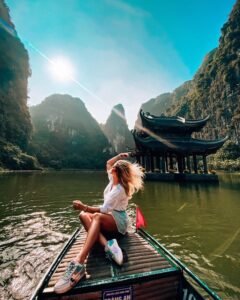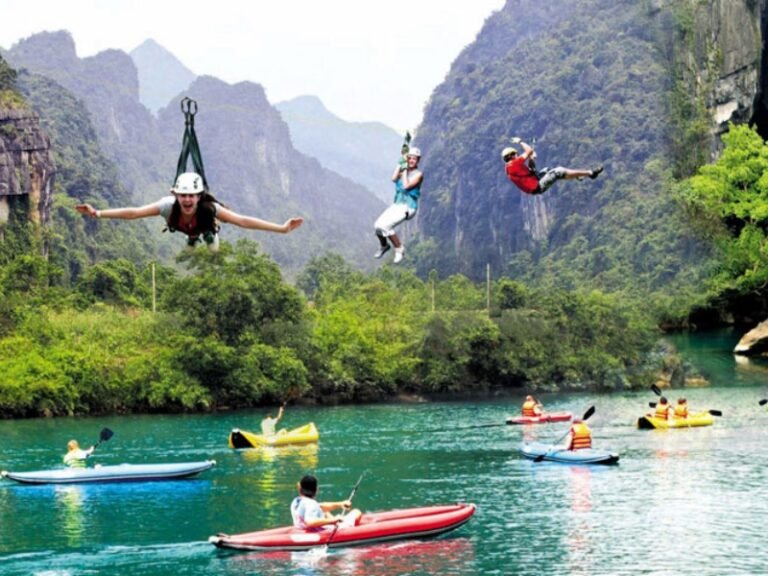Trekking Northern Vietnam: Explore Sapa & Fansipan
 ngocdiem
ngocdiem Trekking in Northern Vietnam offers a unique blend of adventure and cultural discovery, with stunning landscapes and vibrant ethnic villages. This region boasts iconic destinations like Sapa trekking, where terraced rice fields and welcoming locals create unforgettable experiences, and Fansipan trekking, challenging adventurers to conquer “The Roof of Indochina.” Whether you seek breathtaking mountain views or a deeper connection with Vietnam’s rich heritage, trekking Northern Vietnam promises a journey of awe and inspiration
1. Why Choose Northern Vietnam for Trekking?
Trekking Northern Vietnam captivates travelers with its diverse natural landscapes, ranging from majestic mountains to serene valleys and dense forests. The region is a treasure trove of scenic beauty, offering panoramic views that leave trekkers in awe. Whether it’s the misty peaks of the Hoang Lien Son range or the tranquil green valleys dotted with traditional homes, the natural allure here is unmatched.
Beyond its landscapes, the area provides a perfect blend of adventure and culture. Trekkers can immerse themselves in the daily life of ethnic villages, interacting with communities such as the H’mong and Red Dao. These encounters offer insights into unique traditions, warm hospitality, and a way of life deeply connected to nature.


Adding to its appeal are the ideal weather conditions. Northern Vietnam’s climate, especially during autumn and spring, is cool and refreshing, making it the perfect time for outdoor activities like trekking. Combined, these factors make Northern Vietnam a top choice for both seasoned adventurers and beginners seeking an unforgettable journey.
👝 Explore: Cuc Phuong National Park: Trekking Through Vietnam’s First Park
2. Top Trekking Destinations in Northern Vietnam
2.1. Sapa Trekking
Sapa trekking is one of the most popular and rewarding experiences in Northern Vietnam. Nestled in the Hoang Lien Son mountain range, Sapa offers picturesque trails that wind through lush terraced rice fields, bamboo forests, and serene valleys. Key attractions like Lao Chai, Ta Van, and Cat Cat villages provide not only breathtaking scenery but also an opportunity to interact with local ethnic groups such as the H’mong and Red Dao.


These cultural experiences add depth to the adventure, allowing trekkers to learn about traditional crafts, enjoy authentic cuisine, and witness daily life in these vibrant communities. Whether you’re exploring on a single-day trek or a multi-day journey, Sapa trekking guarantees a harmonious blend of nature and culture.
2.2. Fansipan Trekking
For those seeking a more challenging adventure, Fansipan trekking is a must. Known as “The Roof of Indochina,” Fansipan stands tall at 3,147 meters, making it the highest peak in Vietnam. Trekkers can choose from various routes, ranging from beginner-friendly trails to more demanding paths for seasoned adventurers.
Reaching the summit is a rewarding experience, offering panoramic views of the surrounding mountains and valleys. For those who prefer a less strenuous option, the Fansipan cable car provides a quicker yet equally breathtaking ascent. Whether trekking or taking the cable car, Fansipan trekking offers an unforgettable experience, blending natural grandeur with a sense of accomplishment.

3. What to Expect When Trekking in Northern Vietnam
Trekking in Northern Vietnam is an adventure filled with excitement and surprises. Trekkers can expect challenges during the journey, such as steep terrains, slippery paths during the rainy season, and fluctuating weather. These obstacles add to the thrill and make the experience even more rewarding for those seeking a true adventure.
What sets this region apart is the warm hospitality and unique cuisine offered by the local ethnic groups. Villagers often welcome trekkers with open arms, sharing traditional dishes like sticky rice, smoked meats, and herbal teas. These encounters leave travelers with lasting memories of heartfelt connections.


Additionally, the stunning natural scenery is nothing short of breathtaking. From mist-covered mountains to vibrant terraced rice fields, Northern Vietnam offers countless photo opportunities for capturing the beauty of nature at its best. Whether you’re a seasoned trekker or a beginner, every step promises unparalleled views and experiences.
👝 Explore: Hon Ba Mountain: Trekking to the “Second Da Lat” near Nha Trang
4. Best Time for Trekking in Northern Vietnam
The best time for trekking Northern Vietnam is during the autumn (September to November) and spring (March to May) seasons. These periods offer mild weather, with cool temperatures and minimal rainfall, creating the perfect conditions for trekking.


In autumn, the rice fields in Sapa trekking turn golden, providing stunning landscapes that captivate every traveler. Spring, on the other hand, is marked by blooming flowers and clear skies, making it ideal for capturing vibrant natural scenes.
Avoid the summer months due to heavy rains, which can make trails slippery and challenging, and the winter months, which can bring cold and foggy conditions. By planning your trek during these optimal seasons, you’ll enjoy both the natural beauty and favorable weather, ensuring a memorable experience.
👝 Explore: What To Eat In Sapa? Top 5 Must-Try Dishes For Tourists
5. Tips for a Safe and Enjoyable Trekking Experience
To fully enjoy trekking Northern Vietnam, preparation is key. Start by packing essentials such as sturdy trekking shoes, a raincoat, and a basic first-aid kit with necessary medicines. These items ensure comfort and safety during your journey, especially when traversing uneven or wet terrain.
Hiring local guides is highly recommended. They provide not only valuable insights into the trails but also cultural knowledge about the villages and communities you’ll encounter. A guide can significantly enhance your experience by ensuring you stay on track and make the most of your trek.
Lastly, remember to follow environmental protection guidelines. Respect nature by avoiding littering, sticking to designated trails, and minimizing disruption to local wildlife. Sustainable trekking ensures the preservation of these beautiful landscapes for future generations.
🌟 If you need or want to explore some tours to Vietnam, you can explore some Vietnam tours below or contact us via WhatsApp or visit the Sun Getaways Travel Fanpage.
6. How to Plan Your Trekking Trip
Planning a trekking trip in Northern Vietnam is key to ensuring an unforgettable experience. This region offers a unique mix of culture, nature, and adventure, so thoughtful preparation will make your trip seamless. Here’s a detailed guide:
6.1. Choosing the Right Itinerary
The itinerary depends on your fitness level, interests, and time. A 3-5 day trek is ideal for exploring the highlights of Northern Vietnam.
- 📌 Day 1:
- 📍 Arrive in Sapa and begin your trek to Lao Chai and Ta Van villages.
- 📍 Walk through terraced rice fields, enjoy stunning mountain views, and interact with the local Hmong and Dzay communities.
- 📍 Overnight stay in a traditional homestay to immerse yourself in the culture.
- 📌 Day 2:
- 📍 Visit Cat Cat Village, a picturesque village known for its waterfalls and handicrafts.
- 📍 Continue trekking through lush valleys to the base of Mount Fansipan, the “Roof of Indochina.”
- 📍 Stay overnight at a hotel or lodge near the Fansipan base.
- 📌 Day 3-4:
- 📍 Begin the Fansipan trek. Depending on your fitness level, you can:
- 🔖 Option 1: Complete a full trek to the summit, which typically takes 1-2 days with a guide.
- 🔖 Option 2: Combine trekking with the cable car for a less strenuous ascent.
- 📍 Enjoy panoramic views from the summit, including the surrounding Hoang Lien Son mountain range.
- 📍 Begin the Fansipan trek. Depending on your fitness level, you can:
- 📌 Day 5:
- 📍 Spend your morning exploring Sapa town or visiting nearby attractions like Silver Waterfall or Love Waterfall.
- 📍 Depart for your next destination.


6.2 Booking Accommodations and Guides
- ☄️ Choose reputable tour operators to handle logistics, including transportation, accommodations, and guides.
- ☄️ Popular operators in the region include Ethos Spirit of the Community, Sapa Sisters, and others. These ensure ethical tourism by supporting local communities.
- ☄️ Homestays are a great way to experience the culture, while lodges or hotels offer more comfort after a long day of trekking.
6.3 Transportation
- ☄️ Take an overnight train or sleeper bus from Hanoi to Sapa for a convenient and cost-effective journey.
- ☄️ Private car services are also available if you prefer more comfort and flexibility.
6.4 Packing Essentials
- ☄️ Comfortable trekking shoes, a raincoat, layered clothing (the weather can change quickly), and a small backpack.
- ☄️ Don’t forget sunscreen, a hat, and reusable water bottles.
- ☄️ Carry some cash as ATMs might be scarce in rural areas.
👝 Explore: ATMs in Vietnam: Finding Cash & Avoiding Fees
6.5 Health and Safety Tips
- ☄️ Ensure you have travel insurance covering trekking activities.
- ☄️ Stay hydrated, and acclimate yourself to the altitude, especially during the Fansipan trek.
- ☄️ Listen to your guide and follow safety protocols.
7. FAQs Section
1. How long does it take to trek to Fansipan?
Trekking to Fansipan typically takes 1-2 days, depending on the route chosen and your fitness level
2. Is it necessary to hire a guide for trekking in Sapa?
While not mandatory, hiring a guide is highly recommended for navigating trails, understanding local culture, and ensuring safety.
3. Which trekking spots are suitable for beginners?
Beginners can start with easier trails like those in Lao Chai, Ta Van, and Cat Cat villages, which offer gentle paths and scenic views.
Trekking in Northern Vietnam offers stunning landscapes, rich cultural experiences, and unforgettable adventures. From the scenic trails of Sapa trekking to the challenge of Fansipan trekking, this region has something for everyone. Let Sun Getaways Travel help you plan the perfect trekking adventure. Start your journey today and explore the magic of Northern Vietnam!
👉 Additionally, you can also check out “What to buy in Sapa” and “Best street food in Sapa” to enhance and perfect your trekking trip plans!
Ask a question
Leave a Comment (0)
No questions yet. Be the first to ask a question!




















